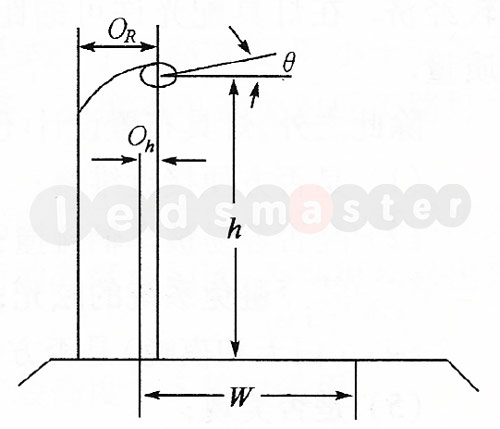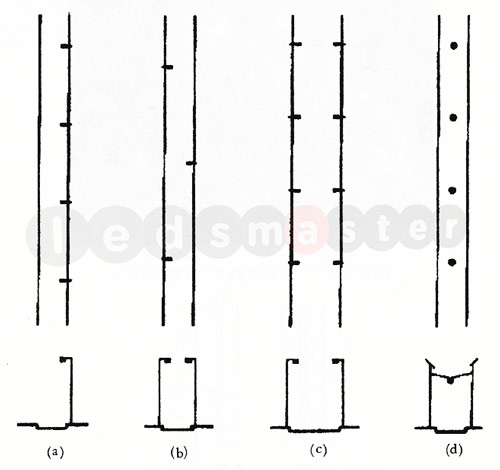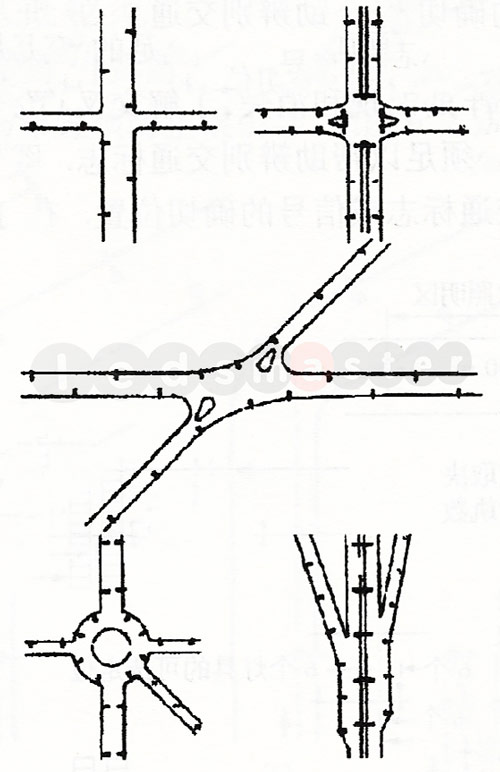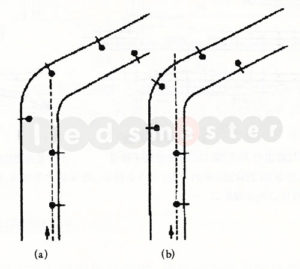Picture streets that come alive after dark, where every light fixture adds a splash of brilliance to the cityscape, turning mundane routes into inviting corridors of safety and beauty.
Get your complimentary lighting design today
When designing road lighting, the layout must consider the road’s characteristics, such as brightness and uniformity requirements, as well as the specifications of the lighting fixtures, including their power, lumen output, and beam angle. Achieving the optimal street lighting design requires a thorough evaluation of functionality, aesthetics, and investment costs. This article provides insights into both fundamental and advanced concepts, and demonstrates how our LED street lights meet the diverse needs of various lighting projects.
Table of Contents
ToggleStreet lighting fixtures are typically mounted on the extending arms of light poles. To effectively describe the installation parameters, we need to consider factors such as installation height, cantilever length, elevation angle, and other key metrics.
 The installation height of street lights is crucial for effective road lighting. This height, measured as the vertical distance from the center of the lamp to the road surface, typically ranges from 6 to 14 meters. The chosen height depends on factors such as road width and desired illumination.
The installation height of street lights is crucial for effective road lighting. This height, measured as the vertical distance from the center of the lamp to the road surface, typically ranges from 6 to 14 meters. The chosen height depends on factors such as road width and desired illumination.
Higher installation heights generally enhance lighting quality by reducing glare and improving uniformity. Elevating the light source allows for broader light distribution, covering more area and enabling greater spacing between poles. This can reduce the number of fixtures needed and potentially lower costs.
However, higher poles require fixtures with higher power ratings and lumen outputs, which can increase initial costs and energy consumption. Despite these costs, the advantages of reduced glare and improved uniformity often justify the investment.
Advancements in lighting technology, particularly in LED efficiency, have significantly impacted pole heights. Modern LEDs now achieve efficiencies between 130 and 180 lumens per watt (lm/W), making taller poles more feasible and cost-effective. High poles are commonly used, especially in areas like highway interchanges, where they offer better uniformity and an aesthetically pleasing solution.
In some cases, shorter poles are preferred for aesthetic reasons or specific functional needs, such as decorative street lamps or ceiling-mounted garden lights in residential areas, which help blend with the environment and enhance visual appeal.
The cantilever length of street light fixtures refers to the horizontal distance from the edge of the road to the center of the light source. This dimension is crucial in determining how light is distributed across the road surface and surrounding areas. Increasing the cantilever length can enhance the brightness of the road surface directly beneath the fixture, but it can also diminish the illumination of adjacent sidewalks and areas beyond the road.
The cantilever length plays a vital role in determining the lux level, which measures the intensity of light on the pavement and other surfaces. If the cantilever length is fixed, using asymmetric optics on the street lights can help balance illumination levels. Asymmetric optics are designed to direct light more efficiently where it is needed, reducing light spill and ensuring even distribution across the desired areas.
Choosing the appropriate cantilever length involves balancing several factors. Increasing the length can be beneficial for wide roads or areas where greater brightness is needed, but it may require careful consideration to avoid creating dark spots on sidewalks or other adjacent areas. The goal is to achieve an optimal balance where the road surface receives adequate illumination without compromising the visibility of nearby areas.
The lamp elevation angle is the angle between the light fixture’s opening and the horizontal plane. This parameter influences how far the light projects and its distribution pattern. A higher elevation angle allows the light to cover a larger area and reach further distances. However, it can also increase the amount of glare experienced by pedestrians and drivers, which may cause discomfort and affect safety.
Typically, the elevation angle is maintained within 15° to strike a balance between effective light distribution and minimizing glare. By controlling the elevation angle, it is possible to achieve a lighting design that provides ample illumination while reducing the potential for glare. Proper adjustment of this angle ensures that light is distributed evenly across the road surface without creating harsh or uncomfortable lighting conditions for those using the area.
Street light spacing refers to the distance between adjacent light poles. Determining the optimal spacing involves considering various factors, including pole positioning, road grid size (such as the distance between crosswalks), terrain, and surrounding buildings. Proper spacing is essential for achieving uniform lighting across the road and ensuring that all areas are adequately illuminated.
Economically, using high-luminous fixtures with greater installation height and wider spacing can be more cost-effective. This approach reduces the number of poles needed and can lower installation and maintenance costs. However, achieving effective lighting design and layout requires careful consideration of several key factors:
 For two-way traffic roads, selecting the appropriate lighting layout is crucial for effective illumination. One common arrangement is the single-side layout, which is suitable for roads where the width is less than or equal to the installation height of the lamp. In this setup, the side of the road with the street lamp receives more light, while the opposite side remains dimmer.
For two-way traffic roads, selecting the appropriate lighting layout is crucial for effective illumination. One common arrangement is the single-side layout, which is suitable for roads where the width is less than or equal to the installation height of the lamp. In this setup, the side of the road with the street lamp receives more light, while the opposite side remains dimmer.
Another option is the staggered layout, which works well when the road width is between 1 and 1.5 times the height of the lamp. This design can enhance uniformity but requires careful attention to avoid uneven light distribution, which can create alternating bright and dark spots. For roads where the width exceeds 1.5 times the lamp installation height, the double-side (relative) layout is typically used, providing more even illumination across the entire road. In cases where roads are flanked by narrow buildings, the hanging layout can be employed. Here, lamps are mounted on steel cables stretched across the road, which is effective for illuminating narrow spaces.

On highways equipped with central dividers, the central catenary lamp arrangement is a highly effective lighting strategy. This setup involves strategically placing light posts along the central isolation belt of the highway, with the fixtures typically spaced between 10 and 20 meters apart. The design is specifically tailored to provide comprehensive illumination across the road, significantly enhancing overall visibility.
To further improve the quality of lighting, an alternating design is often employed. This involves alternating the positions of the lamps to ensure that light is evenly distributed on both sides of the central divider. This technique not only maximizes the illumination on the road surface but also extends the coverage to the areas adjacent to the central divider. By doing so, the lighting design ensures that drivers can clearly see the road markings, signs, and potential hazards from a greater distance.
The central catenary arrangement delivers several notable benefits. Firstly, it provides excellent visual guidance for road users, helping to delineate lanes and improve the overall driving experience. The consistent and uniform light distribution helps eliminate dark spots and shadowed areas, thereby enhancing safety for all road users. Additionally, this layout effectively reduces glare, which can be a significant issue on high-speed roads, by controlling the direction and spread of light.
In essence, the central catenary lamp arrangement is particularly well-suited for maintaining high levels of visibility and safety on wide highways with central dividers. Its ability to evenly light both sides of the road while minimizing glare makes it a preferred choice for ensuring clear and safe driving conditions on such expansive roadways.
 At road intersections, roundabouts, or ramps, effective street lighting is essential for preventing traffic jams and guiding drivers to the correct exits. The general principles for intersection lighting involve using higher lux levels to ensure sufficient brightness and employing different colors for crossroad illumination to create higher contrast.
At road intersections, roundabouts, or ramps, effective street lighting is essential for preventing traffic jams and guiding drivers to the correct exits. The general principles for intersection lighting involve using higher lux levels to ensure sufficient brightness and employing different colors for crossroad illumination to create higher contrast.
Typically, pole heights of 12 to 18 meters are used to enhance brightness at intersections. For more complex intersections, high mast lighting, which exceeds 20 meters in height, is often employed. This type of lighting provides broad illumination and better guidance compared to traditional street lighting, which can obstruct sightlines. High mast lighting involves installing multiple illuminators, such as floodlights, on very tall poles, offering extensive coverage for large areas.
However, this design can result in light pollution and energy wastage, as light may be projected beyond the intended area. Despite these drawbacks, high mast lighting is also suitable for large plazas, parking lots, and squares. Proper planning is necessary to optimize power, lumen output, elevation angle, and uniformity. Our lighting engineers are ready to assist with designing a tailored lighting plan for your project—contact us today.
 For roads with a large turning radius (greater than 1000 meters), standard street lighting arrangements are generally sufficient and do not require special considerations. However, for roads with a smaller turning radius, where the width is less than 1.5 times the height of the luminaire, the lighting design should be adjusted.
For roads with a large turning radius (greater than 1000 meters), standard street lighting arrangements are generally sufficient and do not require special considerations. However, for roads with a smaller turning radius, where the width is less than 1.5 times the height of the luminaire, the lighting design should be adjusted.
In such cases, street lamps should be placed outside the curve to provide unilateral lighting. This arrangement helps prevent misdirection and ensures that drivers have clear visibility around the curve. Adjustments to the spacing between poles may be necessary to accommodate varying degrees of curvature.
Street lighting design hinges on critical installation parameters, including height, cantilever length, elevation angle, and spacing. Higher poles enhance lighting quality and uniformity but demand fixtures with greater power. Cantilever length determines how light is distributed, while the elevation angle must balance coverage with glare reduction. Proper spacing is essential for even illumination and efficient maintenance.
Different road types, such as two-way roads, lanes with dividers, intersections, and curves, each require tailored lighting solutions for optimal visibility and safety. For instance, central catenary and high mast lighting are well-suited for highways and intersections, whereas curved roads may need adjusted lamp placements. Thoughtful design and installation improve lighting performance, safety, and aesthetics.